Remember when the world shut down for COVID five years ago? My inbox immediately filled with emails from brands explaining how they were reacting to this unexpected shift. Some were spectacular. Most weren’t, although many became more helpful or reassuring as the pandemic wore on and we learned what our customers needed to hear from us.
Today, it’s 2020 all over again, but with tariffs. We face another unexpected bout of uncertainty and apprehension. We aren’t confined to quarters as we were back then, but many of us are feeling rattled again thanks to business disruptions, supply chain challenges and recession worries.
The “P” word is back, as in “pivot,” or deviating from the marketing plan you came up with last year that might be outdated now. Once again, email should be your go-to channel when you tell customers what they can expect from your company and your brands.
The reassurance emails are back, too. Some are still more focused on pushing the corporate line than reassuring customers or letting them know what to expect. But many of the emails I’ve seen look like their brands took cues from their COVID-era predecessors, sending more honest messaging that speaks more to their customers’ concerns and less to pushing for a few more sales.
How you say it is as important as what you say
Has your company contacted customers to discuss tariffs and how they could affect your operations and their experience with your brand? Or are you watching the news and talking with your advisers about what to expect?
If your company is still in “wait and see” mode, now is the time to act, even if the only message you can send is to explain how tariffs will (or could) disrupt operations, force you to raise prices or substitute or discontinue some imported products, or why you won’t be changing things for now.
Maybe those discussions are internal right now. More realistically, look at your program and identify the automations or emails you might need to change based on your outlook of what could happen.
Right now, we’re in a holding period. The U.S. just struck a new trade deal with Britain, which will affect some tariffs, but many more are still out there. We know more now than in early April and the following weeks, when the U.S. introduced, rescinded, reduced, increased or paused tariffs.
Things might even change between the day I write this and the day you read it in MarTech. (Like Monday’s pause on new tariffs with China. — ed.)
But you need to revise your messaging strategy and start communicating now.
That strategy will evolve as the tariff landscape changes, even if you expect to feel few effects or benefit from them. Whatever the case, having a coordinated and flexible email strategy you update as conditions warrant was the winning formula during the COVID pandemic and the right move now.
Create your strategy first. A message to customers could be one strategic step in your tariff response plan, but it’s not the only one. Keep reaching out as conditions change. Customers don’t like sudden changes or being caught unaware by price hikes or sold-out products. Well-timed and carefully produced email messages — not just promotional announcements — can keep them in the loop and prepared for change.
The C-level will direct many of these actions as they consider messaging implications and the company’s position. That’s why you must be at the table where they make those decisions — so you can represent your channel and demonstrate how it can work to achieve the goal.
Dig deeper: How tariffs impact retail sales and ad spending, and why 2025 might be different
Some examples of tariff messages
So far, B2C marketers are winning the tariff-communication game.
Béis
The best email I’ve seen yet comes from luggage retailer Béis, which sent this email to its customers shortly after the first round of tariffs went into effect.
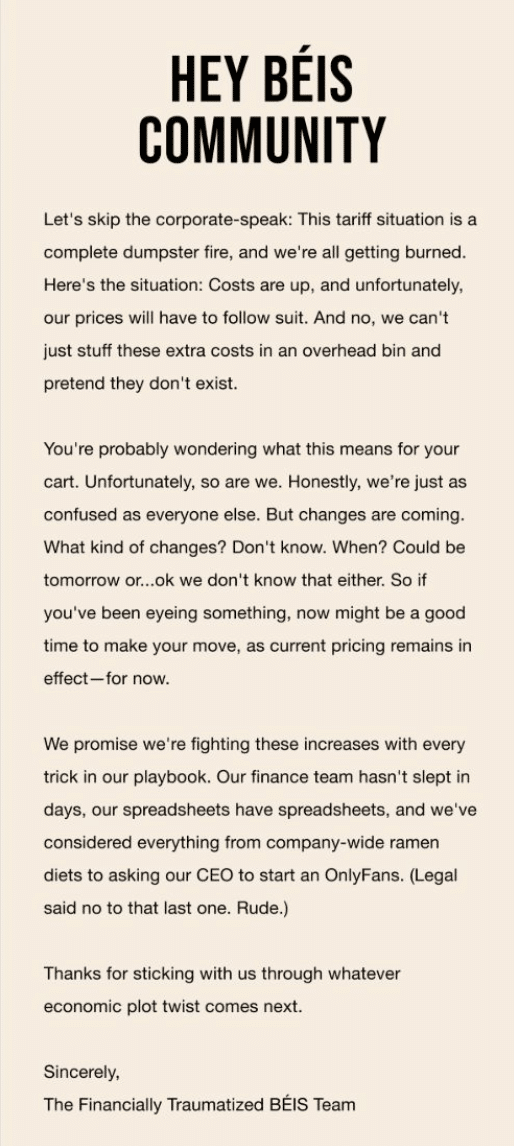
Why it works
It’s transparent. At the time, nobody knew how tariffs would affect their China-based production or prices. The company sent out this email to customers and subscribers, and it has become legendary for mixing honesty and humor.
It also sneaks in a subtle “Buy what you want before the price goes up” message, but that commercial aspect doesn’t negate the other points. It also leaves the door open to price hikes without overstating that possibility.
The tone is a bit casual, in tune with the brand’s voice in emails and web copy. Your message should reflect your brand voice, not just repeat something clever you read here. My point here is to sound human. Email is personal, human and one-to-one. It shouldn’t sound like something legal approved.
Deolax
- Subject line: We’ve been holding this off for a while…
- Preheader: But starting April 25th, some of our prices will change — here’s why.
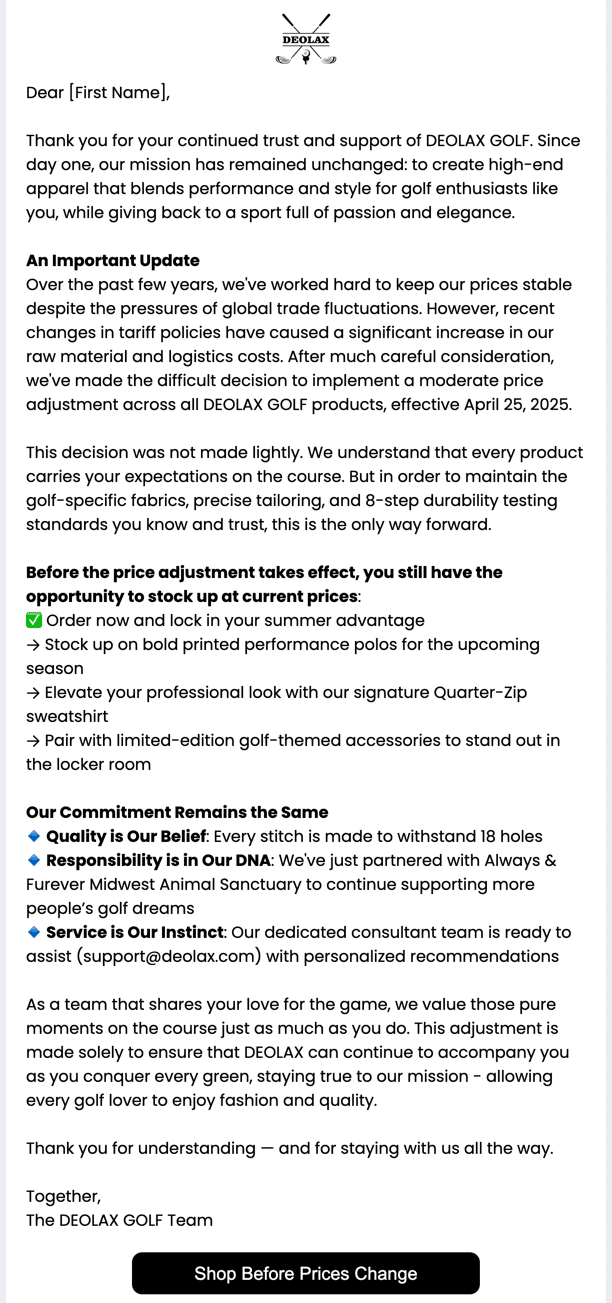
Why it works
This message leans heavily on product quality over discounts and special pricing. It has a secondary message — “We’re all in this together,” striving to highlight the qualities it shares with its customers, right down to a love of golf and presuming the customer understands why it has to raise prices.
Hem
- Subject line: Hem in the US
 — What you need to know
— What you need to know - Preheader: In light of the newly announced tariffs
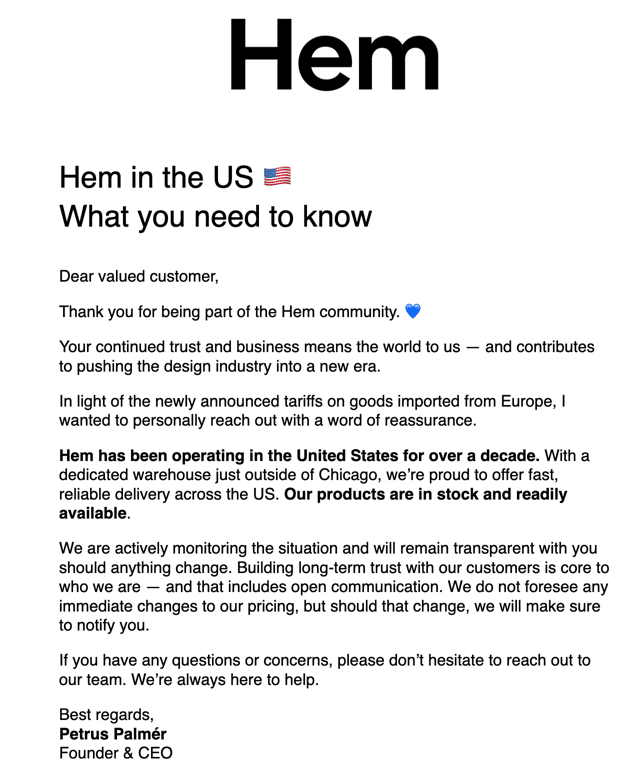
Why it works
Although “valued customer” isn’t the best way to open an email, the rest of the email is a welcome change from the stuffy, stodgy corporate-speak that dulls the impact of a “message from the CEO” email.
I would have emphasized the news that the company wasn’t planning to raise prices because that’s the issue foremost in customers’ minds right now. Otherwise, the email strikes the right tone of reassurance and honesty.
Snibbs
- Subject line: We’ve still got your back
- Preheader: How we’re stepping up

Why it works
The image sets it apart from other tariff messaging because it conveys the feel of Snibbs’ email content, suggesting two Snibbs customers or maybe restaurant workers talking at the end of a long shift. This also keeps the email from looking like a long gray river of type, like the emails from Béis, Deolax and Hem.
The message is straightforward, probably what its working-class customers expect and aims to achieve a goal like the one in the Deolax message — identify the company as an ally with its customers.
One difference: It has no subtle push to buy products before prices go up. I like the button copy, which repeats the company motto: “For Workers, By Workers.” It’s still a button that people can tap to go to the website. It’s just not an obvious “Buy Now” request.
Penzeys Spices
- Subject line: Last Day Before Tariff Pricing
- Preheader: Save 16/25% off everything today
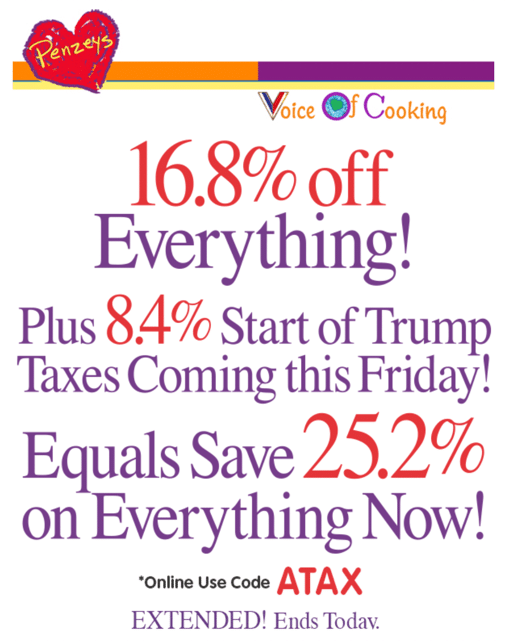
Why it works
And now for something completely different! This is pretty much what customers would expect from a company whose owner, Bill Penzey, seasons his marketing communications — newsletters, website, in-store messaging — with political commentary. (I tried to find tariff-related emails from companies that support the administration’s moves, like Uline and Home Depot. I’m still looking.)
A highly political take might not work for your company, but it’s in line with what Penzeys customers have come to expect. It sticks to the brand’s consistent voice. That’s what you need to advocate for.
Dig deeper: In a world of tariffs and turmoil, marketing’s insight is a superpower
3 tips for effective tariff messaging
Every company will have its right path for tariff messaging. That might even include silence. The variables include how much your business operations will change — if at all — because of the tariffs, how you’ll respond, the makeup of your customer base, what they expect from you, email’s role in customer communications and more.
1. Avoid one-and-done messaging
Follow the news to understand the current tariff landscape, how other companies respond, and whether you need to change your approach or send another email. Your sources include the evening news, business programs, general trade publications like Modern Retail, or industry-specific sources, and social forums.
You probably aren’t the only person in your company following developments, but it never hurts to acquire a reputation as the person who’s most on top of the situation. It will also help you decide when to connect with customers again, especially if you have to raise prices or warn customers of inventory changes.
2. Focus on quality and community over discounts
Your first impulse might be to get customers to spend now before the tariff increases hit. While this might make sense from the CFO’s standpoint, a strategy that relies heavily on discounting isn’t sustainable even in the best times. Once that discount goes away, so might your customers.
Review the Deolax and Snibbs emails above to see how companies focus on quality and shared values over quick sales.
3. Watch for customer signals that you need to update your segments and automations
Are people spending less, even though you have adequate inventory? Are they more or less willing to accept substitutes or rain checks on products you run out of? What shifts do you see among segments from your best customers to your ready-to-churn crew? You might need to adjust segments, messaging and automations to reflect these changes. That’s another reason why tariff messaging won’t be a one-and-done or “say it and forget it” proposition.
Wrapping up: Spend it if you have it
I said that in an earlier MarTech article, “Why smart marketers should front-load spending in 2025,” too. By that, I mean marketers lucky enough to get budget funding for new initiatives should spend it quickly before management can claw it back should markets turn sour. I gave everyone six months to get it done. That might have been a little generous.
But my point remains. If you have it, use it now, especially if it will help you generate more money for the company. With this and your detailed knowledge about tariffs, their effect on your company, the economy in general and customer spending, you’ll go into holiday planning more confidently.
If you’re a marketer told (again) to do more with what you have, now is the time to seek advice (again) on how to maximize your platforms, processes and people. Auditing your program and contacting agencies and your platform providers for help are good first steps.
Just don’t default to the “send more email” mentality. Increasing frequency works during holidays, but the holidays are only a month. The economic impact could go on for a long time.
Wherever you are, actions now will pay off in more strategic planning and less last-minute panic. You’ll be glad in November that you took the extra time in May to plot a sustainable course.
Strap in. It’s going to be a bumpy ride (again).
Dig deeper: How should marketers market to consumers under stress?
The post Winning customer loyalty starts with straight talk about tariffs appeared first on MarTech.
